Financial Analysis of Woolworths Limited: Performance and Strategy
VerifiedAdded on 2020/05/16
|12
|2436
|150
Report
AI Summary
This report provides a comprehensive financial analysis of Woolworths Limited, examining various aspects of its financial performance. It begins with an overview of the company, its ownership and governance structure, and then delves into the calculation of key performance ratios such as return on assets and equity, along with an analysis of debt ratios over the past two years. The report includes a graphical representation of the stock price movement, identifies significant factors influencing the share price, and computes beta values and expected rates of return. Furthermore, it calculates the weighted average cost of capital (WACC) and explains the rationale for conservative investment. The report also covers the company's dividend policy and concludes with a letter of recommendation regarding investment in Woolworths Limited. The analysis is supported by relevant references.
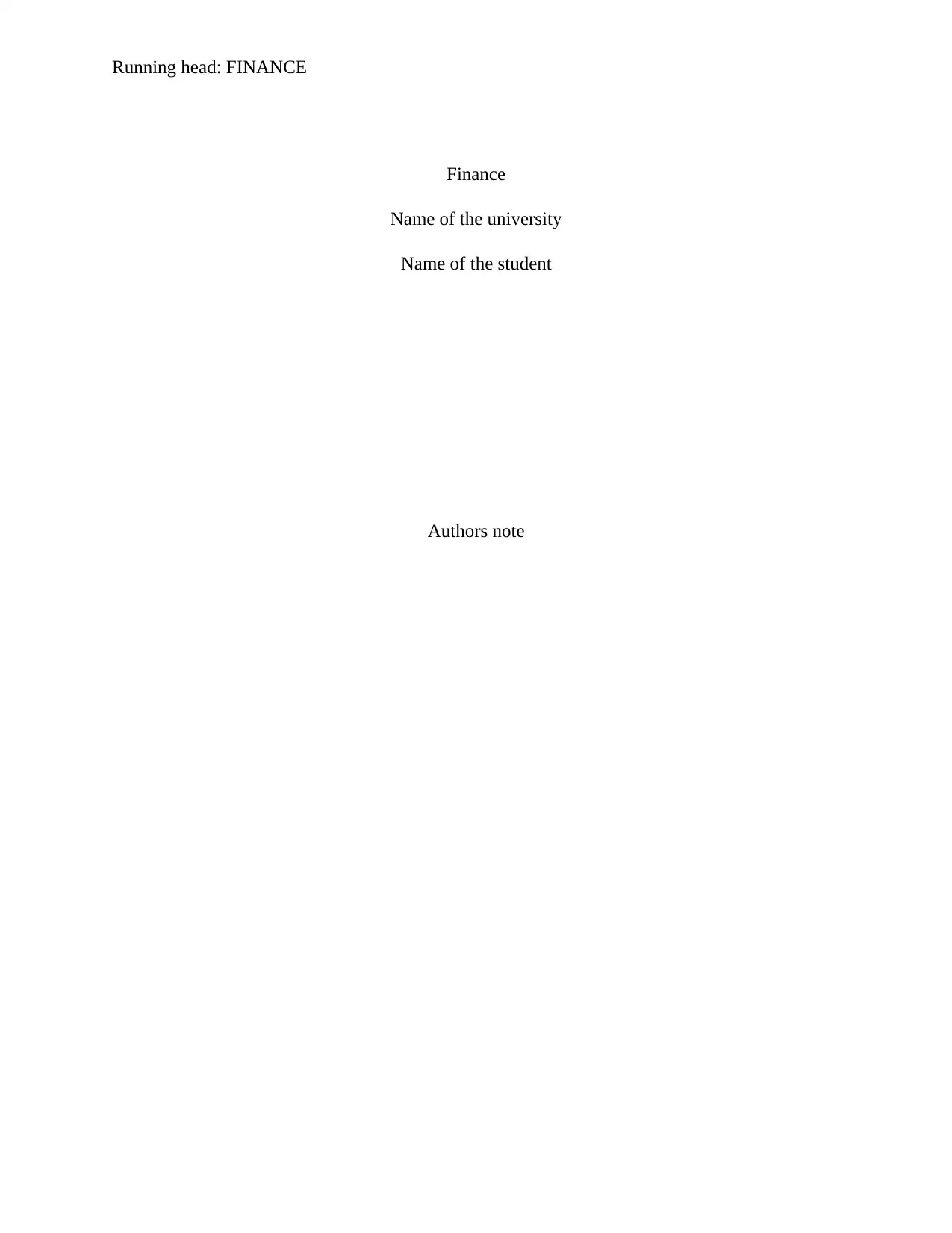
Running head: FINANCE
Finance
Name of the university
Name of the student
Authors note
Finance
Name of the university
Name of the student
Authors note
Paraphrase This Document
Need a fresh take? Get an instant paraphrase of this document with our AI Paraphraser
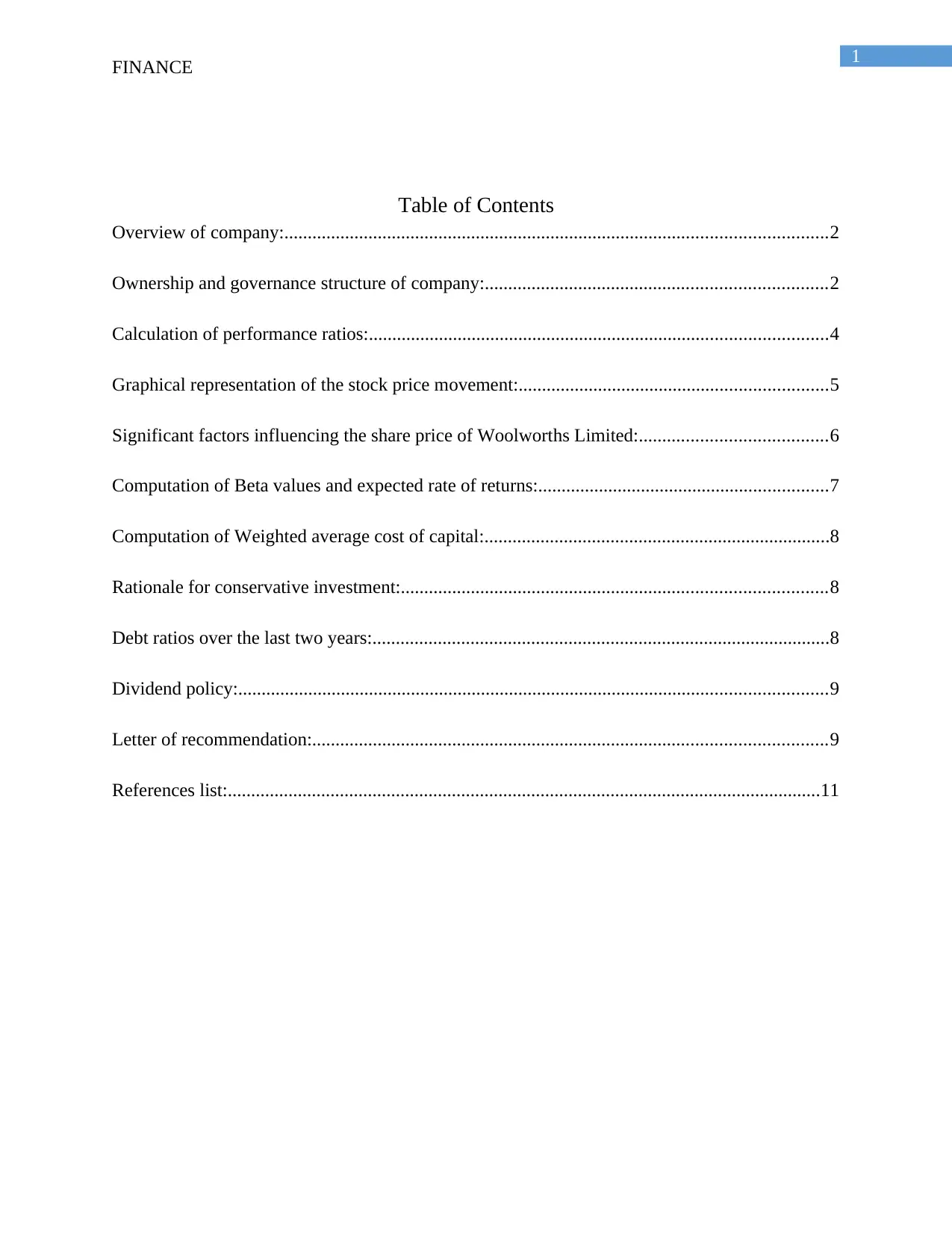
1
FINANCE
Table of Contents
Overview of company:....................................................................................................................2
Ownership and governance structure of company:.........................................................................2
Calculation of performance ratios:..................................................................................................4
Graphical representation of the stock price movement:..................................................................5
Significant factors influencing the share price of Woolworths Limited:........................................6
Computation of Beta values and expected rate of returns:..............................................................7
Computation of Weighted average cost of capital:..........................................................................8
Rationale for conservative investment:...........................................................................................8
Debt ratios over the last two years:..................................................................................................8
Dividend policy:..............................................................................................................................9
Letter of recommendation:..............................................................................................................9
References list:...............................................................................................................................11
FINANCE
Table of Contents
Overview of company:....................................................................................................................2
Ownership and governance structure of company:.........................................................................2
Calculation of performance ratios:..................................................................................................4
Graphical representation of the stock price movement:..................................................................5
Significant factors influencing the share price of Woolworths Limited:........................................6
Computation of Beta values and expected rate of returns:..............................................................7
Computation of Weighted average cost of capital:..........................................................................8
Rationale for conservative investment:...........................................................................................8
Debt ratios over the last two years:..................................................................................................8
Dividend policy:..............................................................................................................................9
Letter of recommendation:..............................................................................................................9
References list:...............................................................................................................................11
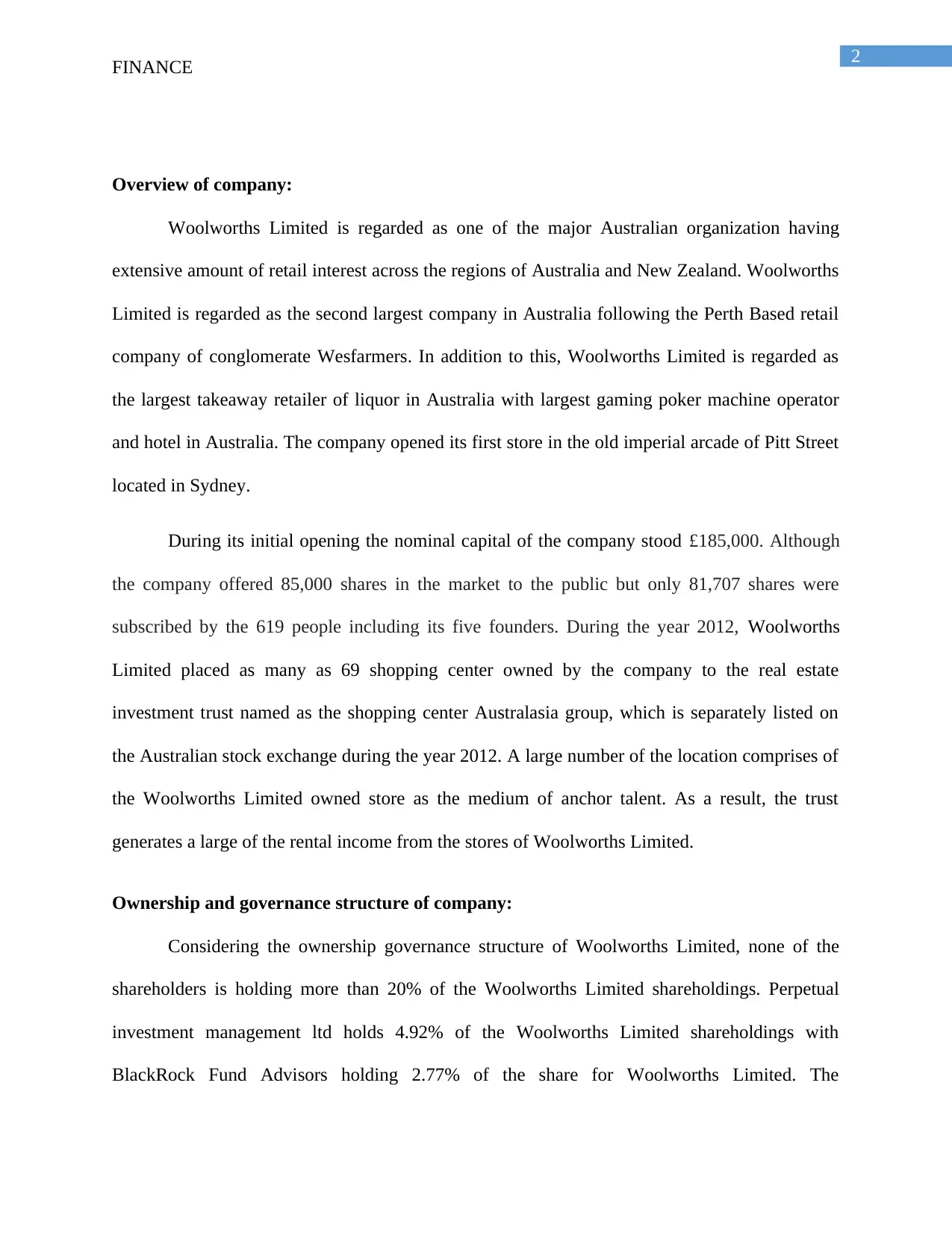
2
FINANCE
Overview of company:
Woolworths Limited is regarded as one of the major Australian organization having
extensive amount of retail interest across the regions of Australia and New Zealand. Woolworths
Limited is regarded as the second largest company in Australia following the Perth Based retail
company of conglomerate Wesfarmers. In addition to this, Woolworths Limited is regarded as
the largest takeaway retailer of liquor in Australia with largest gaming poker machine operator
and hotel in Australia. The company opened its first store in the old imperial arcade of Pitt Street
located in Sydney.
During its initial opening the nominal capital of the company stood £185,000. Although
the company offered 85,000 shares in the market to the public but only 81,707 shares were
subscribed by the 619 people including its five founders. During the year 2012, Woolworths
Limited placed as many as 69 shopping center owned by the company to the real estate
investment trust named as the shopping center Australasia group, which is separately listed on
the Australian stock exchange during the year 2012. A large number of the location comprises of
the Woolworths Limited owned store as the medium of anchor talent. As a result, the trust
generates a large of the rental income from the stores of Woolworths Limited.
Ownership and governance structure of company:
Considering the ownership governance structure of Woolworths Limited, none of the
shareholders is holding more than 20% of the Woolworths Limited shareholdings. Perpetual
investment management ltd holds 4.92% of the Woolworths Limited shareholdings with
BlackRock Fund Advisors holding 2.77% of the share for Woolworths Limited. The
FINANCE
Overview of company:
Woolworths Limited is regarded as one of the major Australian organization having
extensive amount of retail interest across the regions of Australia and New Zealand. Woolworths
Limited is regarded as the second largest company in Australia following the Perth Based retail
company of conglomerate Wesfarmers. In addition to this, Woolworths Limited is regarded as
the largest takeaway retailer of liquor in Australia with largest gaming poker machine operator
and hotel in Australia. The company opened its first store in the old imperial arcade of Pitt Street
located in Sydney.
During its initial opening the nominal capital of the company stood £185,000. Although
the company offered 85,000 shares in the market to the public but only 81,707 shares were
subscribed by the 619 people including its five founders. During the year 2012, Woolworths
Limited placed as many as 69 shopping center owned by the company to the real estate
investment trust named as the shopping center Australasia group, which is separately listed on
the Australian stock exchange during the year 2012. A large number of the location comprises of
the Woolworths Limited owned store as the medium of anchor talent. As a result, the trust
generates a large of the rental income from the stores of Woolworths Limited.
Ownership and governance structure of company:
Considering the ownership governance structure of Woolworths Limited, none of the
shareholders is holding more than 20% of the Woolworths Limited shareholdings. Perpetual
investment management ltd holds 4.92% of the Woolworths Limited shareholdings with
BlackRock Fund Advisors holding 2.77% of the share for Woolworths Limited. The
⊘ This is a preview!⊘
Do you want full access?
Subscribe today to unlock all pages.

Trusted by 1+ million students worldwide
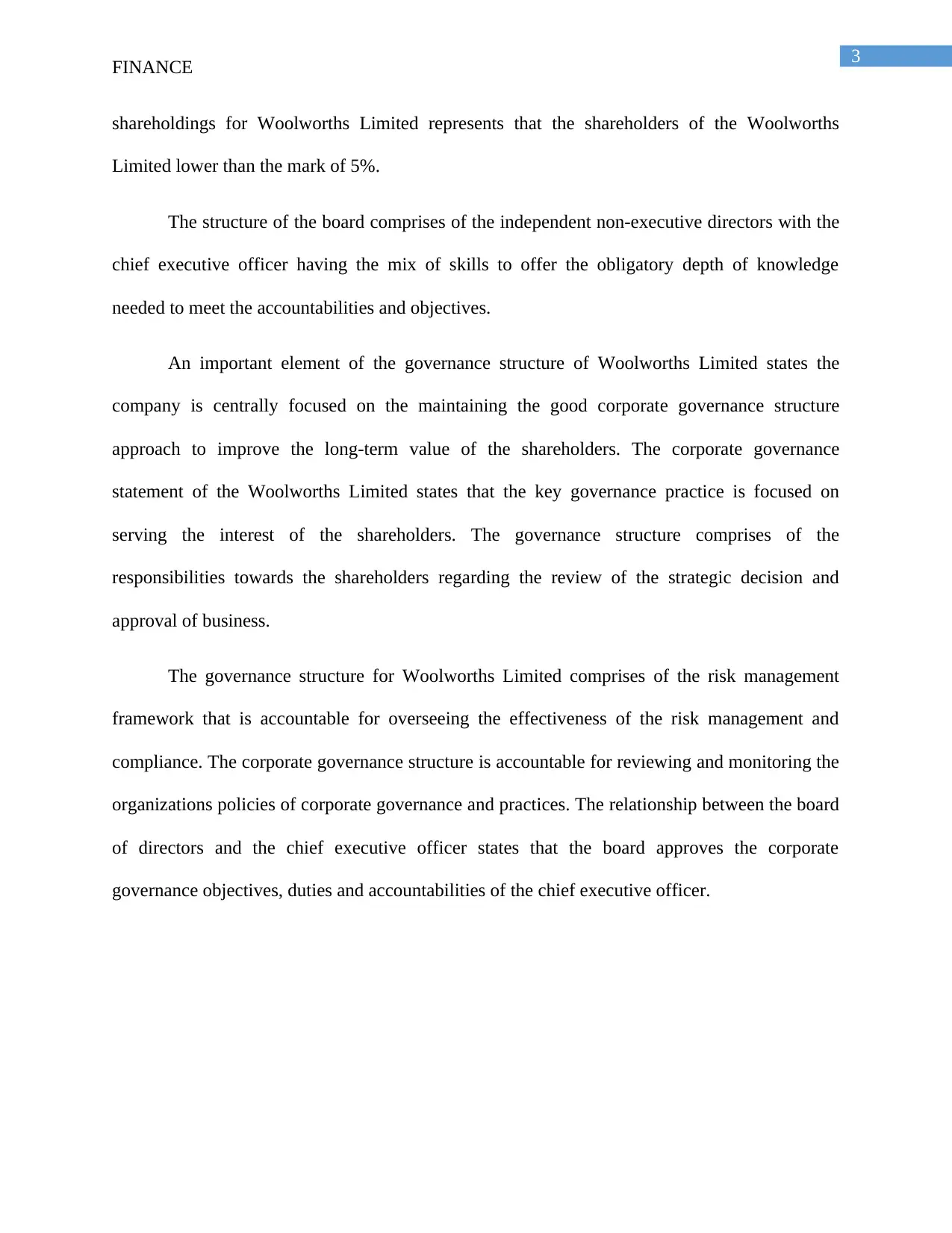
3
FINANCE
shareholdings for Woolworths Limited represents that the shareholders of the Woolworths
Limited lower than the mark of 5%.
The structure of the board comprises of the independent non-executive directors with the
chief executive officer having the mix of skills to offer the obligatory depth of knowledge
needed to meet the accountabilities and objectives.
An important element of the governance structure of Woolworths Limited states the
company is centrally focused on the maintaining the good corporate governance structure
approach to improve the long-term value of the shareholders. The corporate governance
statement of the Woolworths Limited states that the key governance practice is focused on
serving the interest of the shareholders. The governance structure comprises of the
responsibilities towards the shareholders regarding the review of the strategic decision and
approval of business.
The governance structure for Woolworths Limited comprises of the risk management
framework that is accountable for overseeing the effectiveness of the risk management and
compliance. The corporate governance structure is accountable for reviewing and monitoring the
organizations policies of corporate governance and practices. The relationship between the board
of directors and the chief executive officer states that the board approves the corporate
governance objectives, duties and accountabilities of the chief executive officer.
FINANCE
shareholdings for Woolworths Limited represents that the shareholders of the Woolworths
Limited lower than the mark of 5%.
The structure of the board comprises of the independent non-executive directors with the
chief executive officer having the mix of skills to offer the obligatory depth of knowledge
needed to meet the accountabilities and objectives.
An important element of the governance structure of Woolworths Limited states the
company is centrally focused on the maintaining the good corporate governance structure
approach to improve the long-term value of the shareholders. The corporate governance
statement of the Woolworths Limited states that the key governance practice is focused on
serving the interest of the shareholders. The governance structure comprises of the
responsibilities towards the shareholders regarding the review of the strategic decision and
approval of business.
The governance structure for Woolworths Limited comprises of the risk management
framework that is accountable for overseeing the effectiveness of the risk management and
compliance. The corporate governance structure is accountable for reviewing and monitoring the
organizations policies of corporate governance and practices. The relationship between the board
of directors and the chief executive officer states that the board approves the corporate
governance objectives, duties and accountabilities of the chief executive officer.
Paraphrase This Document
Need a fresh take? Get an instant paraphrase of this document with our AI Paraphraser
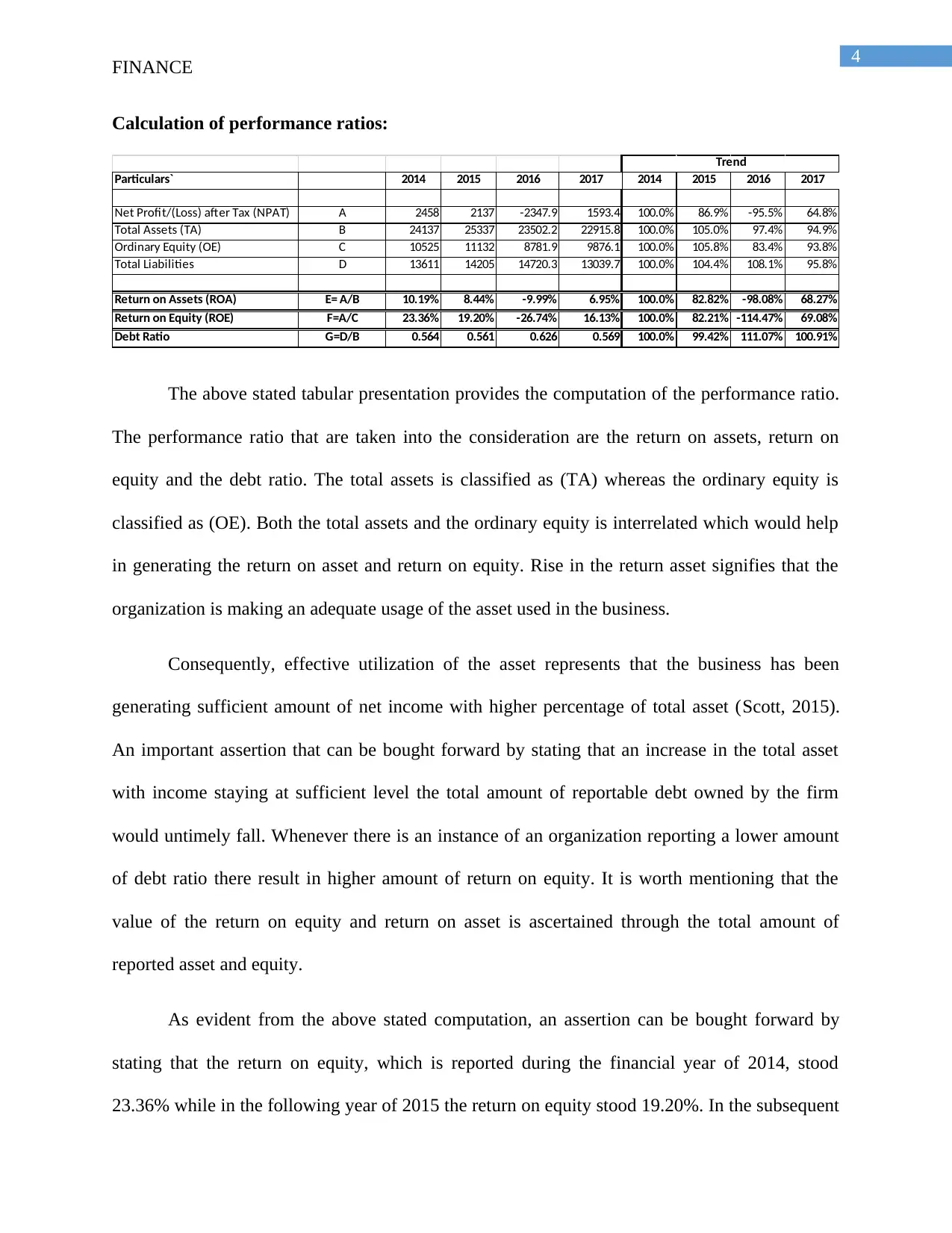
4
FINANCE
Calculation of performance ratios:
Particulars` 2014 2015 2016 2017 2014 2015 2016 2017
Net Profit/(Loss) after Tax (NPAT) A 2458 2137 -2347.9 1593.4 100.0% 86.9% -95.5% 64.8%
Total Assets (TA) B 24137 25337 23502.2 22915.8 100.0% 105.0% 97.4% 94.9%
Ordinary Equity (OE) C 10525 11132 8781.9 9876.1 100.0% 105.8% 83.4% 93.8%
Total Liabilities D 13611 14205 14720.3 13039.7 100.0% 104.4% 108.1% 95.8%
Return on Assets (ROA) E= A/B 10.19% 8.44% -9.99% 6.95% 100.0% 82.82% -98.08% 68.27%
Return on Equity (ROE) F=A/C 23.36% 19.20% -26.74% 16.13% 100.0% 82.21% -114.47% 69.08%
Debt Ratio G=D/B 0.564 0.561 0.626 0.569 100.0% 99.42% 111.07% 100.91%
Trend
The above stated tabular presentation provides the computation of the performance ratio.
The performance ratio that are taken into the consideration are the return on assets, return on
equity and the debt ratio. The total assets is classified as (TA) whereas the ordinary equity is
classified as (OE). Both the total assets and the ordinary equity is interrelated which would help
in generating the return on asset and return on equity. Rise in the return asset signifies that the
organization is making an adequate usage of the asset used in the business.
Consequently, effective utilization of the asset represents that the business has been
generating sufficient amount of net income with higher percentage of total asset (Scott, 2015).
An important assertion that can be bought forward by stating that an increase in the total asset
with income staying at sufficient level the total amount of reportable debt owned by the firm
would untimely fall. Whenever there is an instance of an organization reporting a lower amount
of debt ratio there result in higher amount of return on equity. It is worth mentioning that the
value of the return on equity and return on asset is ascertained through the total amount of
reported asset and equity.
As evident from the above stated computation, an assertion can be bought forward by
stating that the return on equity, which is reported during the financial year of 2014, stood
23.36% while in the following year of 2015 the return on equity stood 19.20%. In the subsequent
FINANCE
Calculation of performance ratios:
Particulars` 2014 2015 2016 2017 2014 2015 2016 2017
Net Profit/(Loss) after Tax (NPAT) A 2458 2137 -2347.9 1593.4 100.0% 86.9% -95.5% 64.8%
Total Assets (TA) B 24137 25337 23502.2 22915.8 100.0% 105.0% 97.4% 94.9%
Ordinary Equity (OE) C 10525 11132 8781.9 9876.1 100.0% 105.8% 83.4% 93.8%
Total Liabilities D 13611 14205 14720.3 13039.7 100.0% 104.4% 108.1% 95.8%
Return on Assets (ROA) E= A/B 10.19% 8.44% -9.99% 6.95% 100.0% 82.82% -98.08% 68.27%
Return on Equity (ROE) F=A/C 23.36% 19.20% -26.74% 16.13% 100.0% 82.21% -114.47% 69.08%
Debt Ratio G=D/B 0.564 0.561 0.626 0.569 100.0% 99.42% 111.07% 100.91%
Trend
The above stated tabular presentation provides the computation of the performance ratio.
The performance ratio that are taken into the consideration are the return on assets, return on
equity and the debt ratio. The total assets is classified as (TA) whereas the ordinary equity is
classified as (OE). Both the total assets and the ordinary equity is interrelated which would help
in generating the return on asset and return on equity. Rise in the return asset signifies that the
organization is making an adequate usage of the asset used in the business.
Consequently, effective utilization of the asset represents that the business has been
generating sufficient amount of net income with higher percentage of total asset (Scott, 2015).
An important assertion that can be bought forward by stating that an increase in the total asset
with income staying at sufficient level the total amount of reportable debt owned by the firm
would untimely fall. Whenever there is an instance of an organization reporting a lower amount
of debt ratio there result in higher amount of return on equity. It is worth mentioning that the
value of the return on equity and return on asset is ascertained through the total amount of
reported asset and equity.
As evident from the above stated computation, an assertion can be bought forward by
stating that the return on equity, which is reported during the financial year of 2014, stood
23.36% while in the following year of 2015 the return on equity stood 19.20%. In the subsequent
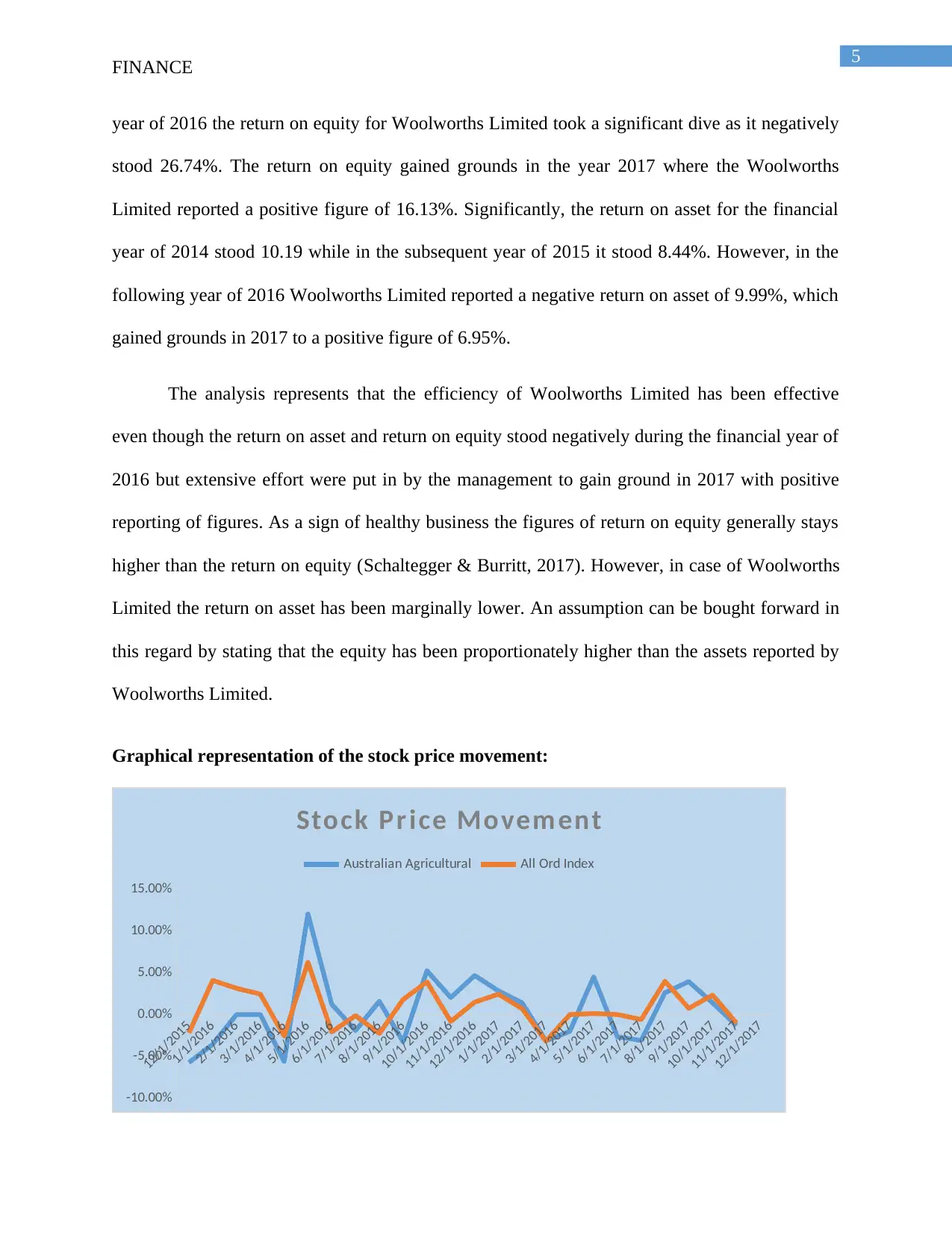
5
FINANCE
year of 2016 the return on equity for Woolworths Limited took a significant dive as it negatively
stood 26.74%. The return on equity gained grounds in the year 2017 where the Woolworths
Limited reported a positive figure of 16.13%. Significantly, the return on asset for the financial
year of 2014 stood 10.19 while in the subsequent year of 2015 it stood 8.44%. However, in the
following year of 2016 Woolworths Limited reported a negative return on asset of 9.99%, which
gained grounds in 2017 to a positive figure of 6.95%.
The analysis represents that the efficiency of Woolworths Limited has been effective
even though the return on asset and return on equity stood negatively during the financial year of
2016 but extensive effort were put in by the management to gain ground in 2017 with positive
reporting of figures. As a sign of healthy business the figures of return on equity generally stays
higher than the return on equity (Schaltegger & Burritt, 2017). However, in case of Woolworths
Limited the return on asset has been marginally lower. An assumption can be bought forward in
this regard by stating that the equity has been proportionately higher than the assets reported by
Woolworths Limited.
Graphical representation of the stock price movement:
12/1/2015
1/1/2016
2/1/2016
3/1/2016
4/1/2016
5/1/2016
6/1/2016
7/1/2016
8/1/2016
9/1/2016
10/1/2016
11/1/2016
12/1/2016
1/1/2017
2/1/2017
3/1/2017
4/1/2017
5/1/2017
6/1/2017
7/1/2017
8/1/2017
9/1/2017
10/1/2017
11/1/2017
12/1/2017
-10.00%
-5.00%
0.00%
5.00%
10.00%
15.00%
Stock Price Movem ent
Australian Agricultural All Ord Index
FINANCE
year of 2016 the return on equity for Woolworths Limited took a significant dive as it negatively
stood 26.74%. The return on equity gained grounds in the year 2017 where the Woolworths
Limited reported a positive figure of 16.13%. Significantly, the return on asset for the financial
year of 2014 stood 10.19 while in the subsequent year of 2015 it stood 8.44%. However, in the
following year of 2016 Woolworths Limited reported a negative return on asset of 9.99%, which
gained grounds in 2017 to a positive figure of 6.95%.
The analysis represents that the efficiency of Woolworths Limited has been effective
even though the return on asset and return on equity stood negatively during the financial year of
2016 but extensive effort were put in by the management to gain ground in 2017 with positive
reporting of figures. As a sign of healthy business the figures of return on equity generally stays
higher than the return on equity (Schaltegger & Burritt, 2017). However, in case of Woolworths
Limited the return on asset has been marginally lower. An assumption can be bought forward in
this regard by stating that the equity has been proportionately higher than the assets reported by
Woolworths Limited.
Graphical representation of the stock price movement:
12/1/2015
1/1/2016
2/1/2016
3/1/2016
4/1/2016
5/1/2016
6/1/2016
7/1/2016
8/1/2016
9/1/2016
10/1/2016
11/1/2016
12/1/2016
1/1/2017
2/1/2017
3/1/2017
4/1/2017
5/1/2017
6/1/2017
7/1/2017
8/1/2017
9/1/2017
10/1/2017
11/1/2017
12/1/2017
-10.00%
-5.00%
0.00%
5.00%
10.00%
15.00%
Stock Price Movem ent
Australian Agricultural All Ord Index
⊘ This is a preview!⊘
Do you want full access?
Subscribe today to unlock all pages.

Trusted by 1+ million students worldwide
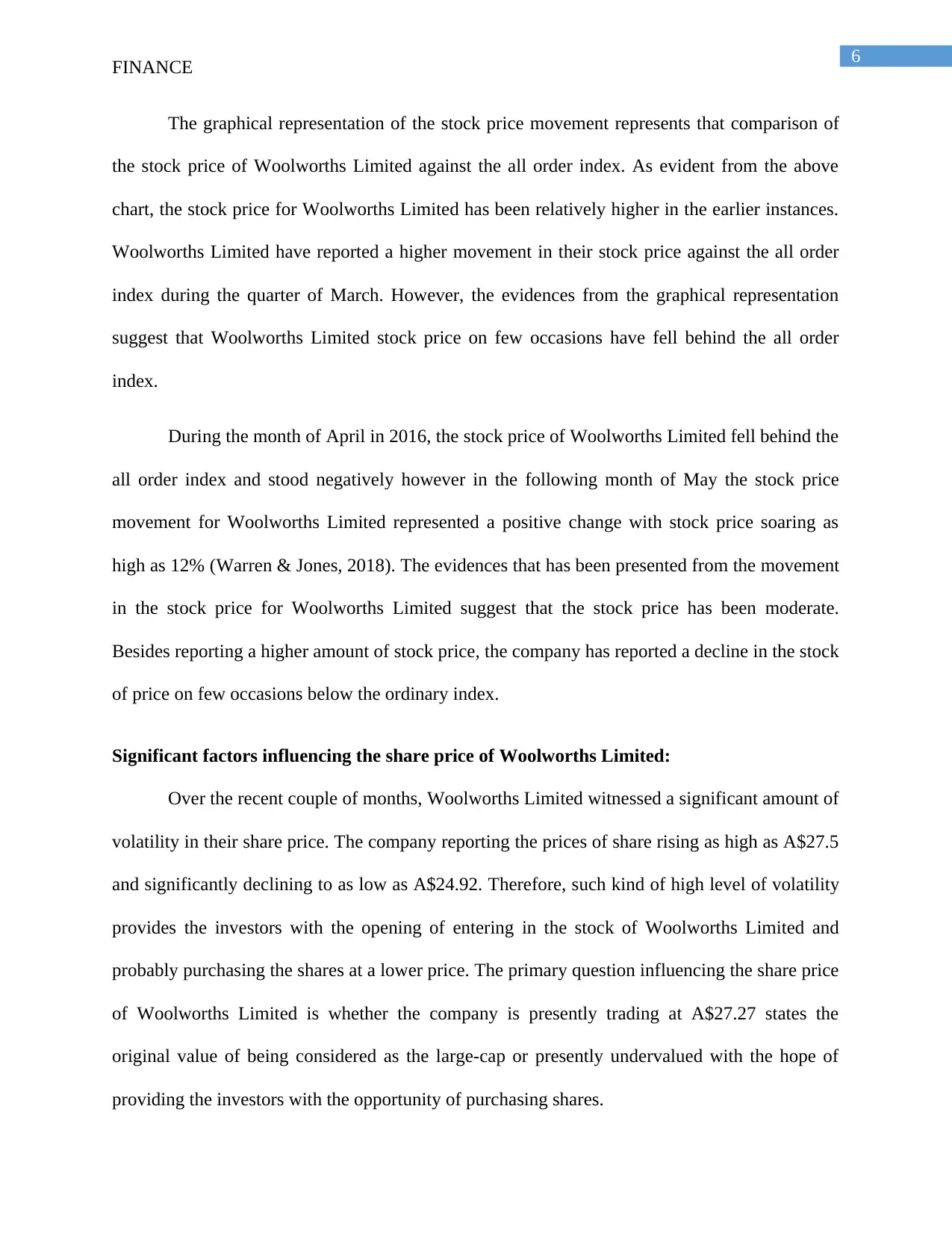
6
FINANCE
The graphical representation of the stock price movement represents that comparison of
the stock price of Woolworths Limited against the all order index. As evident from the above
chart, the stock price for Woolworths Limited has been relatively higher in the earlier instances.
Woolworths Limited have reported a higher movement in their stock price against the all order
index during the quarter of March. However, the evidences from the graphical representation
suggest that Woolworths Limited stock price on few occasions have fell behind the all order
index.
During the month of April in 2016, the stock price of Woolworths Limited fell behind the
all order index and stood negatively however in the following month of May the stock price
movement for Woolworths Limited represented a positive change with stock price soaring as
high as 12% (Warren & Jones, 2018). The evidences that has been presented from the movement
in the stock price for Woolworths Limited suggest that the stock price has been moderate.
Besides reporting a higher amount of stock price, the company has reported a decline in the stock
of price on few occasions below the ordinary index.
Significant factors influencing the share price of Woolworths Limited:
Over the recent couple of months, Woolworths Limited witnessed a significant amount of
volatility in their share price. The company reporting the prices of share rising as high as A$27.5
and significantly declining to as low as A$24.92. Therefore, such kind of high level of volatility
provides the investors with the opening of entering in the stock of Woolworths Limited and
probably purchasing the shares at a lower price. The primary question influencing the share price
of Woolworths Limited is whether the company is presently trading at A$27.27 states the
original value of being considered as the large-cap or presently undervalued with the hope of
providing the investors with the opportunity of purchasing shares.
FINANCE
The graphical representation of the stock price movement represents that comparison of
the stock price of Woolworths Limited against the all order index. As evident from the above
chart, the stock price for Woolworths Limited has been relatively higher in the earlier instances.
Woolworths Limited have reported a higher movement in their stock price against the all order
index during the quarter of March. However, the evidences from the graphical representation
suggest that Woolworths Limited stock price on few occasions have fell behind the all order
index.
During the month of April in 2016, the stock price of Woolworths Limited fell behind the
all order index and stood negatively however in the following month of May the stock price
movement for Woolworths Limited represented a positive change with stock price soaring as
high as 12% (Warren & Jones, 2018). The evidences that has been presented from the movement
in the stock price for Woolworths Limited suggest that the stock price has been moderate.
Besides reporting a higher amount of stock price, the company has reported a decline in the stock
of price on few occasions below the ordinary index.
Significant factors influencing the share price of Woolworths Limited:
Over the recent couple of months, Woolworths Limited witnessed a significant amount of
volatility in their share price. The company reporting the prices of share rising as high as A$27.5
and significantly declining to as low as A$24.92. Therefore, such kind of high level of volatility
provides the investors with the opening of entering in the stock of Woolworths Limited and
probably purchasing the shares at a lower price. The primary question influencing the share price
of Woolworths Limited is whether the company is presently trading at A$27.27 states the
original value of being considered as the large-cap or presently undervalued with the hope of
providing the investors with the opportunity of purchasing shares.
Paraphrase This Document
Need a fresh take? Get an instant paraphrase of this document with our AI Paraphraser
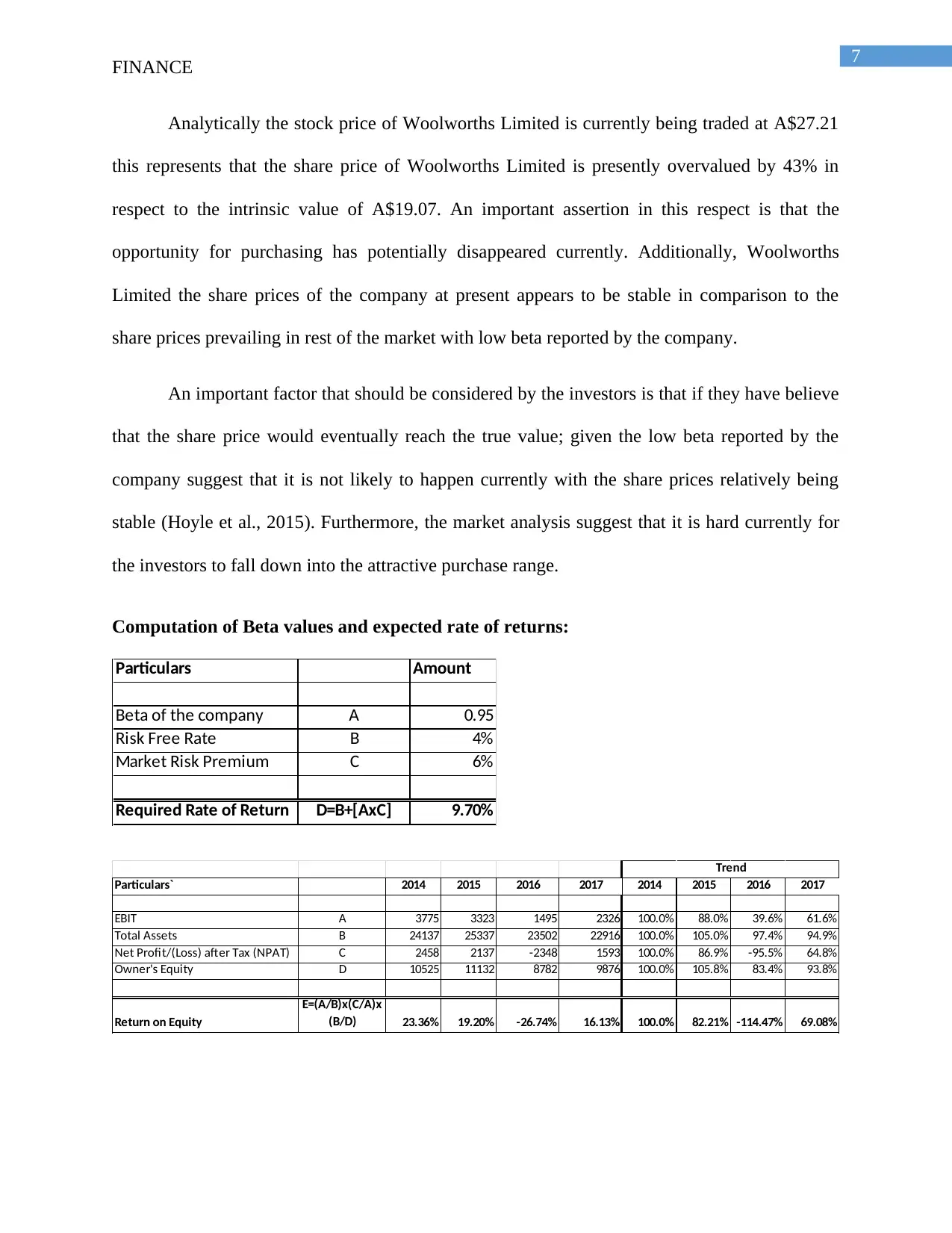
7
FINANCE
Analytically the stock price of Woolworths Limited is currently being traded at A$27.21
this represents that the share price of Woolworths Limited is presently overvalued by 43% in
respect to the intrinsic value of A$19.07. An important assertion in this respect is that the
opportunity for purchasing has potentially disappeared currently. Additionally, Woolworths
Limited the share prices of the company at present appears to be stable in comparison to the
share prices prevailing in rest of the market with low beta reported by the company.
An important factor that should be considered by the investors is that if they have believe
that the share price would eventually reach the true value; given the low beta reported by the
company suggest that it is not likely to happen currently with the share prices relatively being
stable (Hoyle et al., 2015). Furthermore, the market analysis suggest that it is hard currently for
the investors to fall down into the attractive purchase range.
Computation of Beta values and expected rate of returns:
Particulars Amount
Beta of the company A 0.95
Risk Free Rate B 4%
Market Risk Premium C 6%
Required Rate of Return D=B+[AxC] 9.70%
Particulars` 2014 2015 2016 2017 2014 2015 2016 2017
EBIT A 3775 3323 1495 2326 100.0% 88.0% 39.6% 61.6%
Total Assets B 24137 25337 23502 22916 100.0% 105.0% 97.4% 94.9%
Net Profit/(Loss) after Tax (NPAT) C 2458 2137 -2348 1593 100.0% 86.9% -95.5% 64.8%
Owner's Equity D 10525 11132 8782 9876 100.0% 105.8% 83.4% 93.8%
Return on Equity
E=(A/B)x(C/A)x
(B/D) 23.36% 19.20% -26.74% 16.13% 100.0% 82.21% -114.47% 69.08%
Trend
FINANCE
Analytically the stock price of Woolworths Limited is currently being traded at A$27.21
this represents that the share price of Woolworths Limited is presently overvalued by 43% in
respect to the intrinsic value of A$19.07. An important assertion in this respect is that the
opportunity for purchasing has potentially disappeared currently. Additionally, Woolworths
Limited the share prices of the company at present appears to be stable in comparison to the
share prices prevailing in rest of the market with low beta reported by the company.
An important factor that should be considered by the investors is that if they have believe
that the share price would eventually reach the true value; given the low beta reported by the
company suggest that it is not likely to happen currently with the share prices relatively being
stable (Hoyle et al., 2015). Furthermore, the market analysis suggest that it is hard currently for
the investors to fall down into the attractive purchase range.
Computation of Beta values and expected rate of returns:
Particulars Amount
Beta of the company A 0.95
Risk Free Rate B 4%
Market Risk Premium C 6%
Required Rate of Return D=B+[AxC] 9.70%
Particulars` 2014 2015 2016 2017 2014 2015 2016 2017
EBIT A 3775 3323 1495 2326 100.0% 88.0% 39.6% 61.6%
Total Assets B 24137 25337 23502 22916 100.0% 105.0% 97.4% 94.9%
Net Profit/(Loss) after Tax (NPAT) C 2458 2137 -2348 1593 100.0% 86.9% -95.5% 64.8%
Owner's Equity D 10525 11132 8782 9876 100.0% 105.8% 83.4% 93.8%
Return on Equity
E=(A/B)x(C/A)x
(B/D) 23.36% 19.20% -26.74% 16.13% 100.0% 82.21% -114.47% 69.08%
Trend
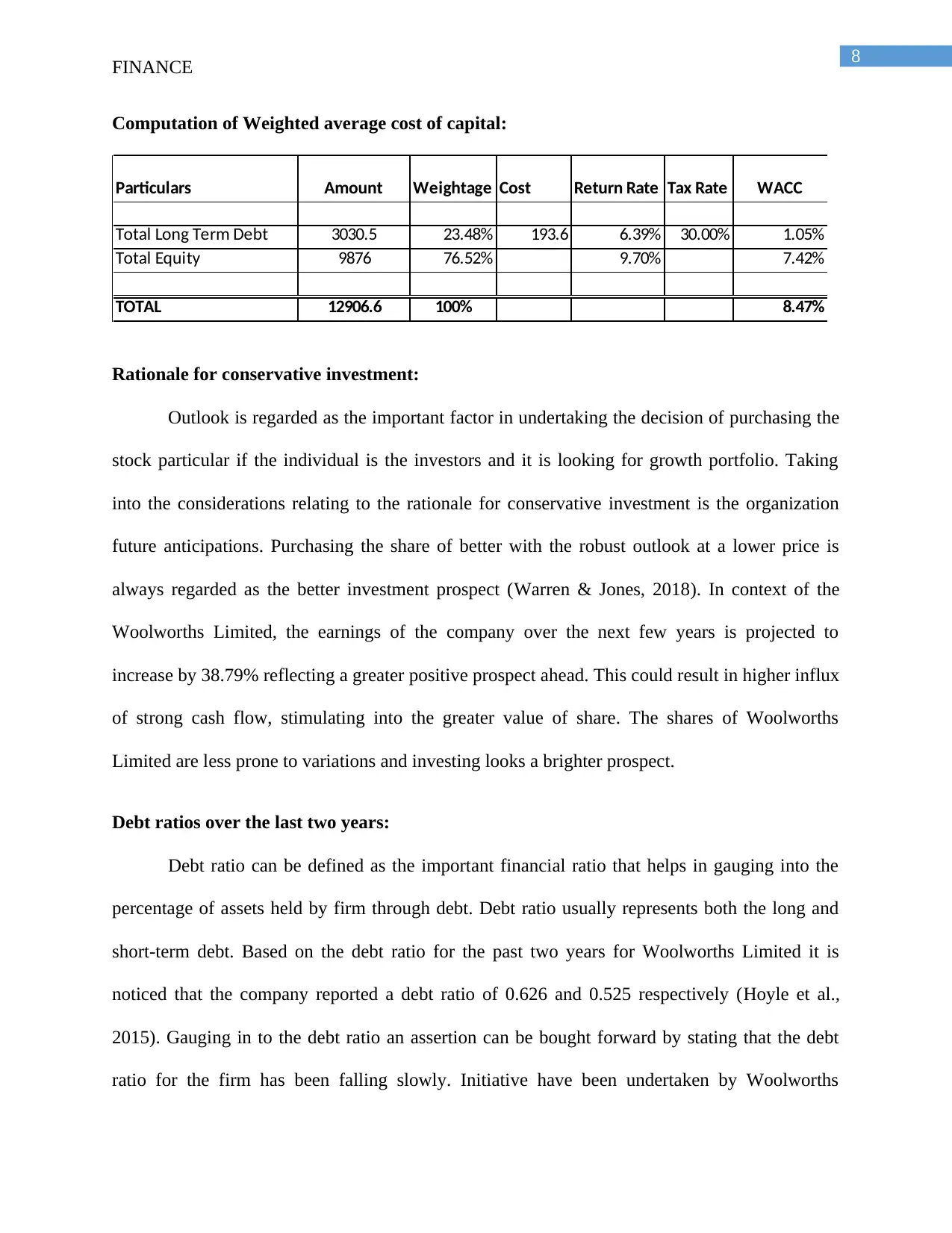
8
FINANCE
Computation of Weighted average cost of capital:
Particulars Amount Weightage Cost Return Rate Tax Rate WACC
Total Long Term Debt 3030.5 23.48% 193.6 6.39% 30.00% 1.05%
Total Equity 9876 76.52% 9.70% 7.42%
TOTAL 12906.6 100% 8.47%
Rationale for conservative investment:
Outlook is regarded as the important factor in undertaking the decision of purchasing the
stock particular if the individual is the investors and it is looking for growth portfolio. Taking
into the considerations relating to the rationale for conservative investment is the organization
future anticipations. Purchasing the share of better with the robust outlook at a lower price is
always regarded as the better investment prospect (Warren & Jones, 2018). In context of the
Woolworths Limited, the earnings of the company over the next few years is projected to
increase by 38.79% reflecting a greater positive prospect ahead. This could result in higher influx
of strong cash flow, stimulating into the greater value of share. The shares of Woolworths
Limited are less prone to variations and investing looks a brighter prospect.
Debt ratios over the last two years:
Debt ratio can be defined as the important financial ratio that helps in gauging into the
percentage of assets held by firm through debt. Debt ratio usually represents both the long and
short-term debt. Based on the debt ratio for the past two years for Woolworths Limited it is
noticed that the company reported a debt ratio of 0.626 and 0.525 respectively (Hoyle et al.,
2015). Gauging in to the debt ratio an assertion can be bought forward by stating that the debt
ratio for the firm has been falling slowly. Initiative have been undertaken by Woolworths
FINANCE
Computation of Weighted average cost of capital:
Particulars Amount Weightage Cost Return Rate Tax Rate WACC
Total Long Term Debt 3030.5 23.48% 193.6 6.39% 30.00% 1.05%
Total Equity 9876 76.52% 9.70% 7.42%
TOTAL 12906.6 100% 8.47%
Rationale for conservative investment:
Outlook is regarded as the important factor in undertaking the decision of purchasing the
stock particular if the individual is the investors and it is looking for growth portfolio. Taking
into the considerations relating to the rationale for conservative investment is the organization
future anticipations. Purchasing the share of better with the robust outlook at a lower price is
always regarded as the better investment prospect (Warren & Jones, 2018). In context of the
Woolworths Limited, the earnings of the company over the next few years is projected to
increase by 38.79% reflecting a greater positive prospect ahead. This could result in higher influx
of strong cash flow, stimulating into the greater value of share. The shares of Woolworths
Limited are less prone to variations and investing looks a brighter prospect.
Debt ratios over the last two years:
Debt ratio can be defined as the important financial ratio that helps in gauging into the
percentage of assets held by firm through debt. Debt ratio usually represents both the long and
short-term debt. Based on the debt ratio for the past two years for Woolworths Limited it is
noticed that the company reported a debt ratio of 0.626 and 0.525 respectively (Hoyle et al.,
2015). Gauging in to the debt ratio an assertion can be bought forward by stating that the debt
ratio for the firm has been falling slowly. Initiative have been undertaken by Woolworths
⊘ This is a preview!⊘
Do you want full access?
Subscribe today to unlock all pages.

Trusted by 1+ million students worldwide
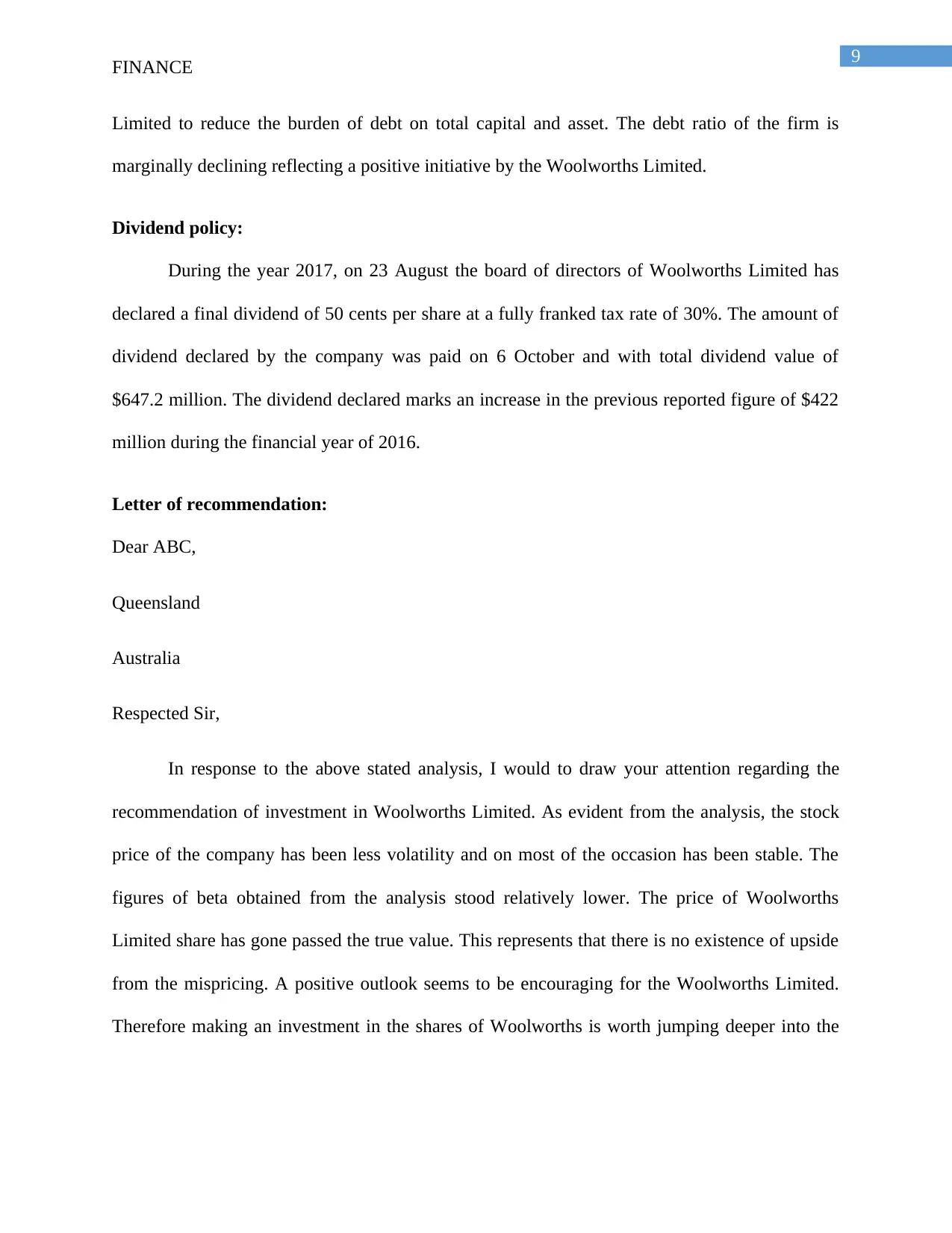
9
FINANCE
Limited to reduce the burden of debt on total capital and asset. The debt ratio of the firm is
marginally declining reflecting a positive initiative by the Woolworths Limited.
Dividend policy:
During the year 2017, on 23 August the board of directors of Woolworths Limited has
declared a final dividend of 50 cents per share at a fully franked tax rate of 30%. The amount of
dividend declared by the company was paid on 6 October and with total dividend value of
$647.2 million. The dividend declared marks an increase in the previous reported figure of $422
million during the financial year of 2016.
Letter of recommendation:
Dear ABC,
Queensland
Australia
Respected Sir,
In response to the above stated analysis, I would to draw your attention regarding the
recommendation of investment in Woolworths Limited. As evident from the analysis, the stock
price of the company has been less volatility and on most of the occasion has been stable. The
figures of beta obtained from the analysis stood relatively lower. The price of Woolworths
Limited share has gone passed the true value. This represents that there is no existence of upside
from the mispricing. A positive outlook seems to be encouraging for the Woolworths Limited.
Therefore making an investment in the shares of Woolworths is worth jumping deeper into the
FINANCE
Limited to reduce the burden of debt on total capital and asset. The debt ratio of the firm is
marginally declining reflecting a positive initiative by the Woolworths Limited.
Dividend policy:
During the year 2017, on 23 August the board of directors of Woolworths Limited has
declared a final dividend of 50 cents per share at a fully franked tax rate of 30%. The amount of
dividend declared by the company was paid on 6 October and with total dividend value of
$647.2 million. The dividend declared marks an increase in the previous reported figure of $422
million during the financial year of 2016.
Letter of recommendation:
Dear ABC,
Queensland
Australia
Respected Sir,
In response to the above stated analysis, I would to draw your attention regarding the
recommendation of investment in Woolworths Limited. As evident from the analysis, the stock
price of the company has been less volatility and on most of the occasion has been stable. The
figures of beta obtained from the analysis stood relatively lower. The price of Woolworths
Limited share has gone passed the true value. This represents that there is no existence of upside
from the mispricing. A positive outlook seems to be encouraging for the Woolworths Limited.
Therefore making an investment in the shares of Woolworths is worth jumping deeper into the
Paraphrase This Document
Need a fresh take? Get an instant paraphrase of this document with our AI Paraphraser
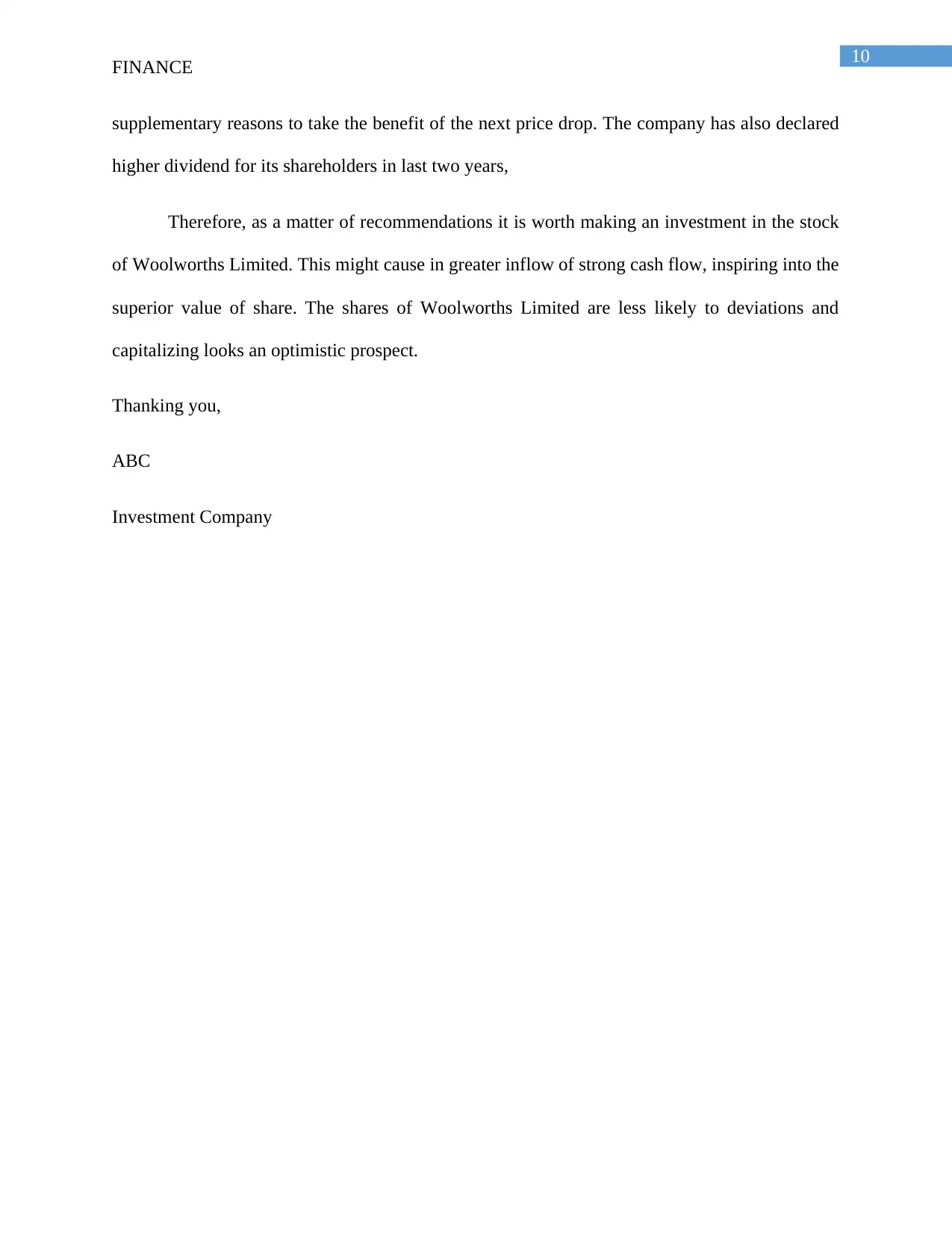
10
FINANCE
supplementary reasons to take the benefit of the next price drop. The company has also declared
higher dividend for its shareholders in last two years,
Therefore, as a matter of recommendations it is worth making an investment in the stock
of Woolworths Limited. This might cause in greater inflow of strong cash flow, inspiring into the
superior value of share. The shares of Woolworths Limited are less likely to deviations and
capitalizing looks an optimistic prospect.
Thanking you,
ABC
Investment Company
FINANCE
supplementary reasons to take the benefit of the next price drop. The company has also declared
higher dividend for its shareholders in last two years,
Therefore, as a matter of recommendations it is worth making an investment in the stock
of Woolworths Limited. This might cause in greater inflow of strong cash flow, inspiring into the
superior value of share. The shares of Woolworths Limited are less likely to deviations and
capitalizing looks an optimistic prospect.
Thanking you,
ABC
Investment Company
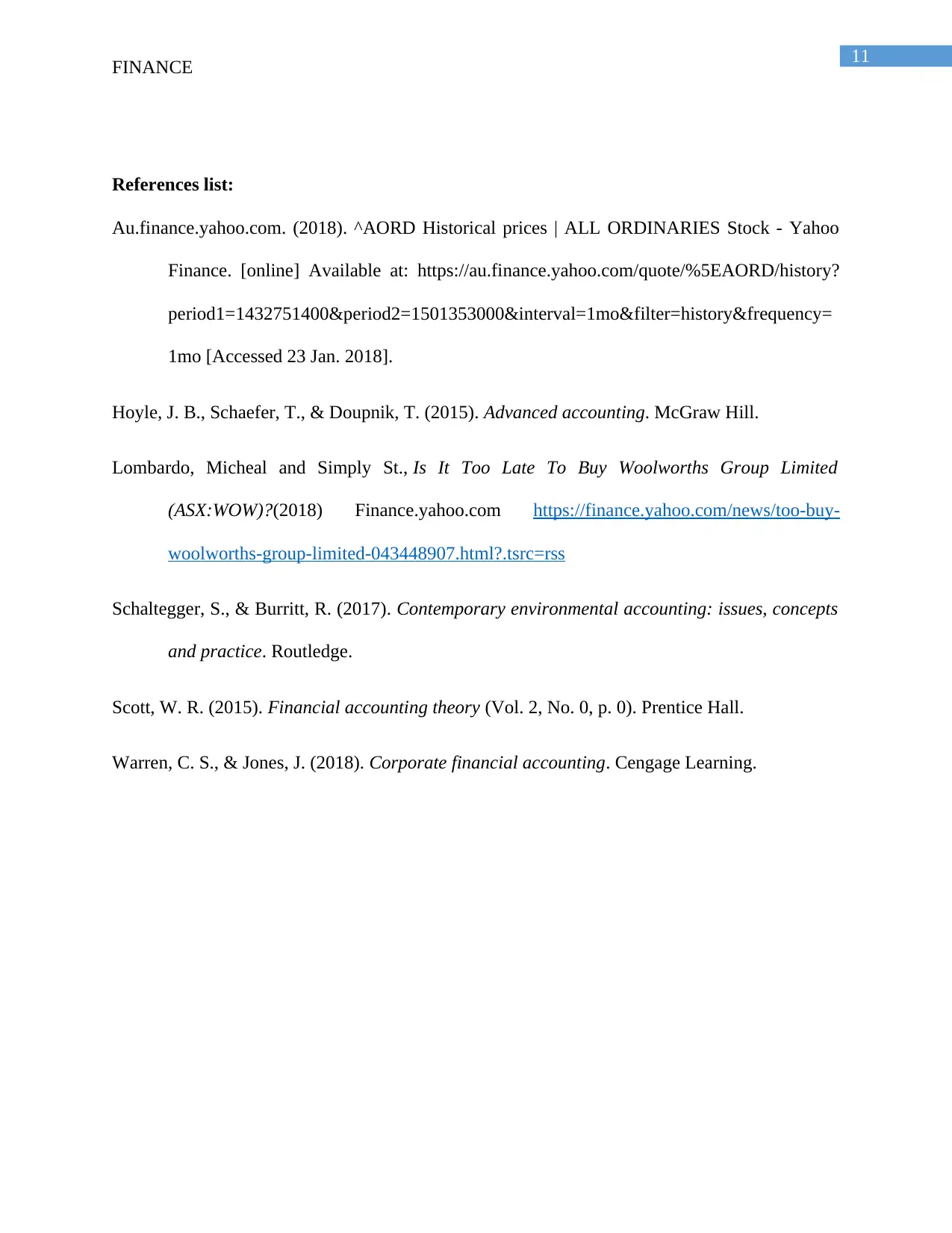
11
FINANCE
References list:
Au.finance.yahoo.com. (2018). ^AORD Historical prices | ALL ORDINARIES Stock - Yahoo
Finance. [online] Available at: https://au.finance.yahoo.com/quote/%5EAORD/history?
period1=1432751400&period2=1501353000&interval=1mo&filter=history&frequency=
1mo [Accessed 23 Jan. 2018].
Hoyle, J. B., Schaefer, T., & Doupnik, T. (2015). Advanced accounting. McGraw Hill.
Lombardo, Micheal and Simply St., Is It Too Late To Buy Woolworths Group Limited
(ASX:WOW)?(2018) Finance.yahoo.com https://finance.yahoo.com/news/too-buy-
woolworths-group-limited-043448907.html?.tsrc=rss
Schaltegger, S., & Burritt, R. (2017). Contemporary environmental accounting: issues, concepts
and practice. Routledge.
Scott, W. R. (2015). Financial accounting theory (Vol. 2, No. 0, p. 0). Prentice Hall.
Warren, C. S., & Jones, J. (2018). Corporate financial accounting. Cengage Learning.
FINANCE
References list:
Au.finance.yahoo.com. (2018). ^AORD Historical prices | ALL ORDINARIES Stock - Yahoo
Finance. [online] Available at: https://au.finance.yahoo.com/quote/%5EAORD/history?
period1=1432751400&period2=1501353000&interval=1mo&filter=history&frequency=
1mo [Accessed 23 Jan. 2018].
Hoyle, J. B., Schaefer, T., & Doupnik, T. (2015). Advanced accounting. McGraw Hill.
Lombardo, Micheal and Simply St., Is It Too Late To Buy Woolworths Group Limited
(ASX:WOW)?(2018) Finance.yahoo.com https://finance.yahoo.com/news/too-buy-
woolworths-group-limited-043448907.html?.tsrc=rss
Schaltegger, S., & Burritt, R. (2017). Contemporary environmental accounting: issues, concepts
and practice. Routledge.
Scott, W. R. (2015). Financial accounting theory (Vol. 2, No. 0, p. 0). Prentice Hall.
Warren, C. S., & Jones, J. (2018). Corporate financial accounting. Cengage Learning.
⊘ This is a preview!⊘
Do you want full access?
Subscribe today to unlock all pages.

Trusted by 1+ million students worldwide
1 out of 12
Related Documents
Your All-in-One AI-Powered Toolkit for Academic Success.
+13062052269
info@desklib.com
Available 24*7 on WhatsApp / Email
![[object Object]](/_next/static/media/star-bottom.7253800d.svg)
Unlock your academic potential
Copyright © 2020–2025 A2Z Services. All Rights Reserved. Developed and managed by ZUCOL.





